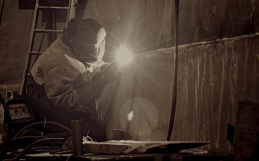When you’re thinking about what process might work best when working with a metal fabricator on a specific project, it often helps to do a comparison of pros and cons. When it comes to laser beam welding and electron beam welding, there are a lot of differences, especially when it comes to overall functionality and physics. Here are the basics of each, so you can decide which one will work best for your project.
Electron Beam Welding:
This process was initially developed in the late 1950s and was soon used by those in the high-tech industries because of its precision and strength. Electron beams can be accurately placed, and it can retain up to 97 percent of the original material strength. This process is considered the best welding process out there, simply because of the quality that it provides to each project.
How it works:
A tungsten filament is heated, then power is applied to it, so the filament releases electronics. These free electrons are accelerated and focused by using electrical fields, and as once this happens, there is significant kinetic energy that happens with the fast-moving electrons. When these electrons make contact with metal, the kinetic energy is transferred to the material, and it is heated almost instantly. This type of welding can weld all weldable metals and some metals that aren’t typically welded, and the result is strength and purity. If there are any impurities during the welding process, the weld will vaporize them.
Laser beam welding:
Lasers were created in the early part of the 1960s and a decade later; automated lasers were being used in welding on production lines. Laser welding systems offer pinpoint accuracy and quick results due to its ability to transfer high amounts of energy during the weld. The laser beam can be focused for harder welds, and it can even be sent down a fiber-optic cable to offer even more control. During laser welding, cover gas is required to keep oxygen out of the welding area. This will improve efficiency and create a purer weld. Laser welding is very popular for use on medical device applications and other electronics because it is easy to apply minimal heat to the parts, which reduces the risk of damage during the process.
If you’re looking for help on which welding process is right for your particular commercial project, our team has decades of hands-on experience. Contact us today for details!





